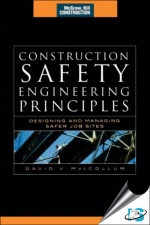Tab Article
Construction Safety Engineering Principles: Designing & Managing Safer Job Sites equips architects, engineers, and construction managers with a step-by-step methodology for identifying and controlling hazards before construction starts. The book explains how to look beyond the utility of machinery and equipment to how they will actually be used on a construction site_and thereby spot potential hazards in advance.
Safety expert David MacCollum presents examples of the 50 most common construction hazards, showing how they can be eliminated by means of proven design techniques and technologies. He explains how to prevent falls from elevations with safe access systems, get rid of blind zones behind mobile equipment, utilize control systems that cannot be unintentionally activated, avoid crane accidents, and much more. Packed with detailed illustrations, Construction Safety Engineering Principles enables construction professionals to:
- Design and plan safer construction sites for residential, commercial, and industrial projects
- Correct safety problems before construction begins
- Dramatically reduce costly worker injuries and job delays
- Increase productivity and create a more cost-effective project


